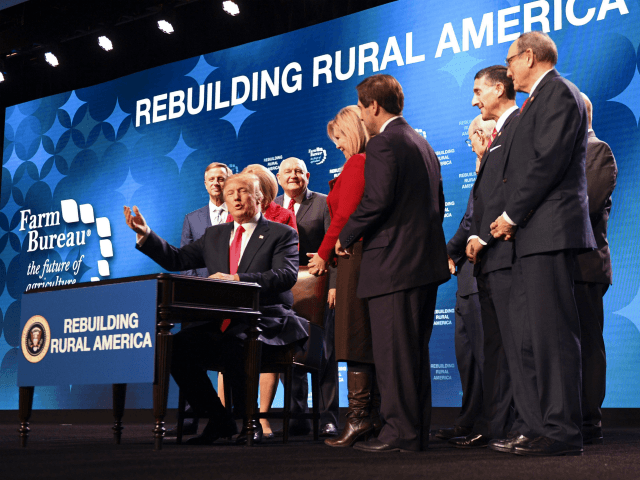President Donald Trump spoke to farmers in Nashville, Tennessee on Monday about his plan to improve the lives of rural Americans, including through the Agriculture and Rural Prosperity Task Force’s report that outlines 100 recommendations to achieve that goal.
The task force, created by a Trump executive order in April, focuses on five areas: expanding fast and affordable Internet to rural populations, promoting economic development through free market strategies and less federal regulations, advancing technological innovation, developing the rural workforce through education and training, and improving quality of life through access to infrastructure, including transportation and health care.
Trump named as chairman of the task force Agriculture Secretary Sonny Perdue, who presented the report to the president during his Nashville visit.
On orders of President Trump: laying out a vision for rural prosperity at the @FarmBureau convention in Nashville. Will present report to @POTUS today:https://t.co/n6gRVnnuNU pic.twitter.com/wxc2hIi4l6
— Sec. Sonny Perdue (@SecretarySonny) January 8, 2018
In a video accompanying the report, a video follows Perdue on his RV trip around the United States to meet with stakeholders in rural America.
“The people in that barn today are the roots of American society — the great farmers and producers, the great spirit in there,” Perdue said following one of those meetings.
The report starts with a letter from Perdue to the president, which says, in part:
E-connectivity, or electronic connectivity, is more than just connecting households, schools, and healthcare centers to each other as well as the rest of the world through high-speed internet. It is also a tool that enables increased productivity for farms, factories, forests, mining, and small businesses. E-connectivity is fundamental for economic development, innovation, advancements in technology, workforce readiness, and an improved quality of life.
Ensuring rural Americans can achieve a high quality of life is the foundation of prosperity. Quality of life is a measure of human well-being that can be identi ed though economic and social indicators. Modern utilities, affordable housing, efficient transportation and reliable employment are economic indicators that must be integrated with social indicators like access to medical services, public safety, education and community resilience to empower rural communities to thrive.
To grow and prosper, every rural community needs job opportunities for its residents, and employers need qualified individuals to fill those needs. This requires identifying employment needs, attracting available workers from urban and rural centers alike, and providing the workforce with training and education to best fill the available needs.
By 2050, the U.S. population is projected to increase to almost 400 million people, and rising incomes worldwide will translate into a historic global growth in food demand. To feed a hungry world, we will need to harness innovation to increase output across American farmlands. In addition to increased crop yields, technological innovation can improve crop quality, nutritional value, and food safety. Innovations in manufacturing, mining, and other non-agricultural industries can enhance worker efficiency and safety.
Expanding funding options to increase the productivity of farmers and ranchers will lead to the enhanced viability and competitiveness of rural America. By promoting innovative farm technologies, energy security, recreation, agritourism and sustainable forest management, communities will be empowered to leverage the bounties of rural America. Investing in rural transportation infrastructure is needed for carrying more “Made in America” products to markets at home and abroad, and boosting our country’s global competitiveness. Reducing regulatory burdens and attracting private capital will support our ultimate mission of empowering rural America to feed the world.
The 43-page report notes that “rural America includes 72 percent of the nation’s land and 46 million people. Rural areas encompass regions that focus on agricultural production as well as places where work is more often found in industries such as manufacturing, mining, and forestry.”
Task Force members include:
• The Secretary of the Treasury
• The Secretary of Defense
• The Attorney General
• The Secretary of the Interior
• The Secretary of Commerce
• The Secretary of Labor
• The Secretary of Health and Human Services
• The Secretary of Transportation
• The Secretary of Energy
• The Secretary of Education
• The Administrator of the Environmental Protection Agency
• The Chairman of the Federal Communications Commission
• The Director of the Office of Management and Budget
• The Director of the Office of Science and Technology Policy
• The Director of the Office of National Drug Control Policy
• The Chairman of the Council of Economic Advisers
• The Assistant to the President for Domestic Policy
• The Assistant to the President for Economic Policy
• The Administrator of the Small Business Administration
• The United States Trade Representative
• The Director of the National Science Foundation

COMMENTS
Please let us know if you're having issues with commenting.